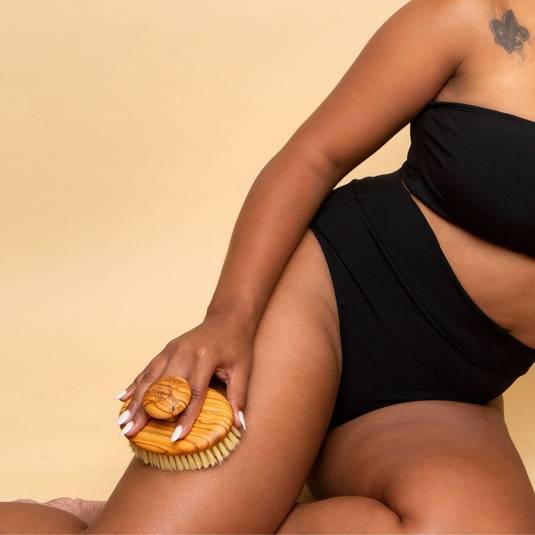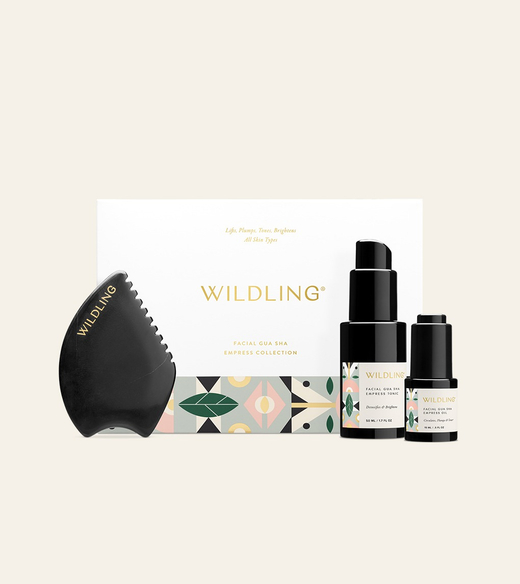If you’re here because you’re flirting with the idea of giving gua sha a try or you’re a pro looking to learn more about the process, you’ve come to the right corner of the Internet.
In fact, you’ve landed squarely in facial gua sha heaven, a place where daily self-care is mandatory and geeking out about lymphatic drainage is cool, admired even.
Lymphatic drainage, say what? Well, without lymph (and its drainage), facial gua sha wouldn’t have immediate results. Like the wind to a sail, lymph is the single, invisible element that makes gua sha effective—it’s one of the the HOWS of gua sha. We won’t judge you if lymphatic drainage isn’t in your lexicon yet. That’s why we’re here now, to spread the lymph gospel. Whether you’re experiencing stress, acne, aging, hyperpigmentation, dull skin, or swelling, prepare to be delighted by what the human body can do via lymph with a little help from our hands and the gua sha stone.
WHAT IS LYMPH?
By definition, lymph is a transparent, colorless fluid that manufactures and carries white blood cells essential to immune function into the bloodstream. It also removes cellular waste that’s leftover from biological processes, essentially Marie Kondo-ing our bodies. Have you ever gotten a blister, popped it, and noticed the clear, not-too-viscous fluid that dribbles out? (We know we’re not the only ones.) If yes, congratulations—you’ve seen lymph in the flesh.
Read more: How to rejuvenate your eyes with the Empress Stone.
The lymphatic system has been an area of medical study and focus as of late because it’s still confuses Western medicine folks. In general, it’s completely ignored by doctors until it becomes an issue, which is unfortunately pretty standard medical care (at least in the United States). Some recent studies suggest what holistic-leaning medicine practitioners have been proposing for hundreds of years: That lymph may play starring role in dis-ease and, thank goodness, in healing too. Here’s what we know about the lymphatic system and how lymphatic drainage works.
THE LYMPHATIC SYSTEM.
Bear with us while we indulge our nerdy side. Unlike the circulatory system that runs on the electrical current of the heart, the lymphatic system lacks a built-in pump. So to keep lymph fluid flowing requires effort (we know, we know) from our muscles, bones, and organs. Rumor has it that jumping on a trampoline is one of the best things you can do to move lymph because it “shakes” the hard-to-reach tissues in the body like no other exercise. We’ll take any excuse to get on a trampoline, let’s be honest, but there are many other ways to move lymph. Facial gua sha is one of the most effective because it works on the head and neck area where—get this—more than 30 percent of our lymph nodes are concentrated (a fact that our very own Britta Plug learned in a course with the acclaimed lymph education center, Dr. Vodder’s Vodderschool).
The lymphatic system itself is downright beautiful. It’s composed of lymph nodes, lymph vessels, and lymph fluid. Lymph nodes are small, spherical structures that act as lymph filters, catching waste and debris that lymph has picked up, like the little garbage collector it is. The nodes are concentrated in certain areas of the body: The head and neck, armpits, abdomen, breasts, groin, and behind the knees. Some sources say humans have between 500 and 600 of lymph nodes! Lymph vessels run up and down the entire body—into arms and legs, into the groin area, around the soft organs of the abdominal cavity—and they are punctuated by the nodes. A lymph vessel’s chief responsibility is to carry the lymph from one place to another.
Read more: Lymphatic drainage Q+A with co-founder Britta Plug.
If you’re getting the sense that the lymph is a little strange, you’re spot on. It is. To add to the freak factor, the lymph is quite disperse: Organs and other body parts are involved in the lymphatic system, too. Bone marrow is where white blood cells are made, and therefore plays a starring role in the lymphatic system. Some of those cells, T-cells, head to the thymus where they go to complete their growth before releasing into the lymphatic system. As a secondary lymphatic organ, the spleen helps to filter the blood and lymph through its system of soft tissue and arteries. Last but certainly not least, our tonsils are also concentrated lymph centers, often being the first to respond (via swelling) to an immune system threat.
LYMPHATIC DRAINAGE BENEFITS.
Yes it’s weird, but it’s also magical. It meets all the qualifications of magic: it’s invisible and makes things disappear and change shape, and helps us in ways we still don’t understand. It causes swelling when something isn’t working the way it should, it rushes fighter immune cells to a site of an infection, and it has been finally recognized by the medical community as a “new organ,” possibly linked to improvement in chronic illnesses and inflammation. In the holistic community, keeping the lymphatic system healthy is associated with certain benefits for the skin and overall well-being. Here are a few ways you can help with your own lymph drainage.
LYMPH AND SKIN.
As purveyors of gua sha as a self-care and skin care practice, we’re a little biased, yes. But we truly believe in the power of lymph to improve the complexion. Through our own individual gua sha practices, as well as our work with clients, we have seen chronic acne clear, puffiness subside, wrinkles fade, and dark spots lighten. Even if you don’t experience any of these particular issues, gua sha works by increasing circulation, which in tandem activates the lymph, awakening tired, dull looking skin. Check out a few of our tips on how to apply the correct pressure during gua sha, in order to receive the aforementioned benefits.
LYMPH AND IMMUNE FUNCTION.
One of the “symptoms” of stagnant lymph is constantly getting sick, which makes sense since the lymph shuttles white blood cells from point A to point B. Sore throat? That’s the lymphatic system in your tonsils turning on, telling your body to ramp up an immune response. You could be feeling congested, dull, and generally achy—the lymphatic system may be responding to a foreign invader. By stimulating the lymph, you’re helping it do its job: clean the blood, clear out the waste, and fighting off potential infections.
LYMPH AND INFLAMMATION.
Inflammation in the body has been pegged by the holistic community as the root of all dis-ease. While sometimes we’re lucky enough to identify a trigger—diet, environment, certain emotions, even—many times, illness and symptoms remain a mystery. But new science shows promise for treatment of inflammation via the lymph, which may explain why alternative modalities like acupuncture, massage, craniosacral therapy, and reiki improve symptoms for people with chronic inflammation and chronic illness.
LYMPH AND MOOD.
Ever notice that you get sick directly after a period of stress, the moment you rest? When your internal and external systems are working harmoniously—blood is pumping and lymph is draining and you’re hydrated and avoiding processed foods—congratulations, you’re winning at life! Your physical body is able to better support you, which helps take the edge off the physical side effects of mental and emotional strife. For most of us this harmonious state of being is fleeting at best. We have babies, jobs, things to do, people to see, and progress to make. Taking the time to drain your lymph is not only self-soothing and calms the nervous system, but can reduce stress and pain levels too, bringing you closer to harmony. One systematic review of existing research linked fibromyalgia patients who received lymphatic massage with lower levels of depression and pain.
HOW-TO: LYMPHATIC DRAINAGE TECHNIQUES.
If you suspect your lymph might be stagnant or simply want to show your nodes some love, here are several ways to help move it along.
Gua sha.
Mhm, we’re biased. We know! But we stand by it. One reason gua sha works is because it moves the lymph! Check out our full tutorial and be sure to avoid these very common gua sha mistakes.
Lymphatic massage.
This isn’t just any old massage. When it comes to lymph, gentle touch is the way. Since lymph collects superficially under the skin, a deep tissue massage bypasses it (for the most part) in favor of the muscles. A lymphatic drainage massage doesn’t feel particularly intense and that’s on purpose. It’s designed to follow the pathways of the lymph, lymph nodes, and uses a soft touch to assist the body in draining and detoxifying. Always talk to your care provider before getting one, especially if you have any medical conditions, as stimulating the lymphatic system may put undue strain on the body.
Lymphatic drainage machine.
Yes. You read that right. There now exists a machine whose sole purpose is to help move our lymph. The “LPG machine,” also known as the lymphatic drainage machine made modern and popular by Los Angeles lymph whisperer Anna Zahn, works like a vacuum on the skin. It moves the lymph with gentle suction. Leave this to the professionals and put your Dysons down, folks!
Dry body brushing.
Dry body brushing is one of the easiest and most accessible ways to help move lymph on your own. To start, purchase a brush with relatively stiff bristles. You don’t want them too firm, otherwise they’ll hurt! Test the brush on the inside of your wrist to see what you can tolerate. It should feel slightly abrasive, but completely bearable. Following the pathway of your lymph, you’ll use light, firm, brisk strokes toward your heart.
Start on the insides of your feet, move up your calves and your thigh. Then brush upwards on the backs of your legs, making sure to cover the behind the knees well—lymph nodes are concentrated there. Moving up toward the hip and groin, be sure to go over your hip creases and inner thighs, where another concentration of lymph nodes lives. Work your way up to your belly and move the dry brush around your belly button in circles. Then, starting at your inner wrist and working your way toward your core, brush up the inner arm, spending a few extra strokes near the armpit, you guessed it, where lymph nodes are concentrated, as you move it in toward your heart. Then you’re done! The process takes just a few minutes and can be done a few times a week.
Compression garments.
Perhaps the sexiest option (joking, but kind of not, see below), wearing compression garments, particularly if you’re traveling, stuck sick in bed, or otherwise immobile for long periods of time can help keep the lymph from pooling in the limbs. Thankfully, a few inventive companies have released compression wear that doesn’t look like it came from the pharmacy.
- We Are Figs women’s compression socks
- COMRAD companion compression socks
- Spanx active compression knee socks
Exercise.
Walking, jogging, jumping on a trampoline, jumping rope, yoga, swimming—anything that gets you moving will get your lymph moving, too. We prefer the trampoline because… have you ever tried it? Jumping on a trampoline is like a fast track to feeling joy.
Breathwork.
Using your diaphragm with breathwork massages the innermost organs like the spleen and the liver that help filter the lymph and blood. The diaphragm rises and falls with the breath, acting like a pump. Getting your diaphragm moving with some deep belly breathing through your nose can help calm your nervous system and may help you move inner lymph, too.
If you wanna try it, we got you. Try this. Find a comfortable seat, whatever that means for you. Inhale and send your breath to your belly, feeling it soften and expand (focusing on your belly expanding, rather than your chest). Inhale even more and fill the lungs wide, and then high. As you exhale, let the breath fall out of you as the belly softens. Continue like this for a few minutes.
Staying hydrated and eating well.
This should probably go without saying, but staying hydrated is key to keeping the lymph mobile! Without adequate water, the body doesn’t have the ingredients it needs to make enough lymph. The same goes for vitamins and nutrients. Without sufficient nutrient intake, particularly fats, as they play a pivotal role in the production and transport of immune system cells, we’re putting our lymph at risk. Be sure to stay hydrated and eat a nutrient-dense diet.
WHAT HAPPENS AFTER LYMPHATIC DRAINAGE, AND HOW DO YOU KNOW IT’S WORKING?
You’ll know it’s working because you’ll start to notice subtle shifts in how you feel. After successful lymphatic drainage of any kind, it’s important to drink a lot of water, stick to eating unprocessed foods, and support your body in the detoxification process. It’s all quite personal and depends on the techniques you’re implementing, how often, as well as your lifestyle. In general, clearer skin, getting sick less often, fewer body aches and headaches, decreased facial puffiness, increased energy, and regular elimination are all signs that your lymphatic system is feeling the love.
You’ve landed squarely in facial gua sha heaven, a place where daily self-care is mandatory and geeking out about lymphatic drainage is cool, admired even.






